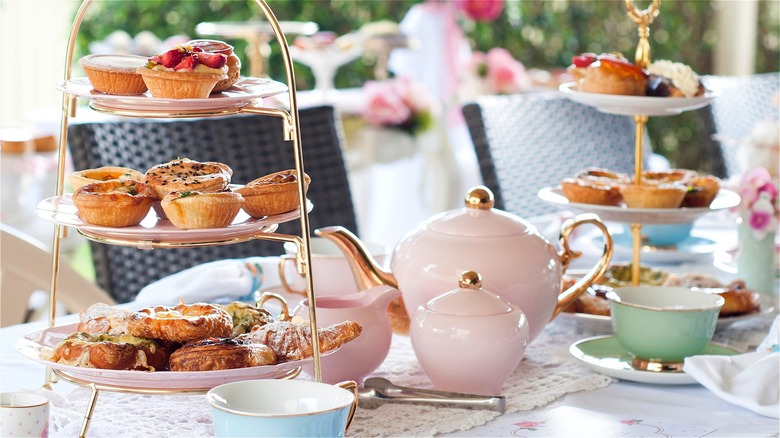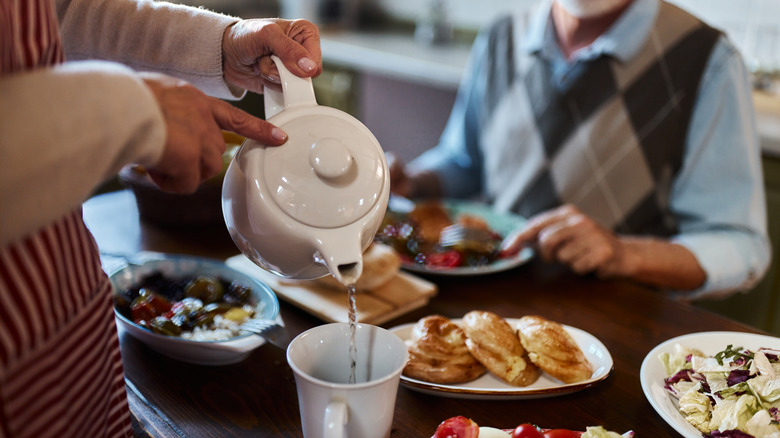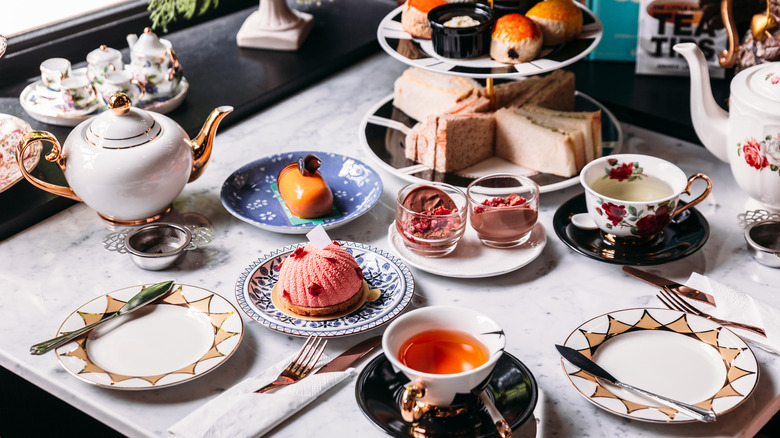High Tea And Afternoon Tea Are Not The Same Thing
For those outside Britain, the term "high tea" might bring to mind images of ornate teapots, lacy doilies, and tiny finger sandwiches. But if you were to visit the U.K. and ask a local where to find the most extravagant local high tea service, you might be met with a confused look. That's because you've probably been picturing afternoon tea all along, and high tea is something different entirely.
Although high tea and afternoon tea are both time-honored British traditions, they are each associated with distinct histories, times of day, locations, table settings, foods, and levels of formality. Despite its more formal-sounding name, high tea is a hearty evening meal enjoyed at home. On the other hand, afternoon tea is a lighter affair accompanied by delicate treats like scones and pastries and may even be served in a restaurant fancy enough to have napkin etiquette rules. So before you raise your pinky and have a tea party of your own, we'll take a moment to distinguish between the two types of tea services.
High tea has more to do with chairs than formality
Contrary to popular conception, the "high" in high tea doesn't confer status as it does with terms like high-fashion or high-society — it actually comes from the chairs in which the drink is typically enjoyed. Where afternoon tea is sometimes referred to as "low tea" due to it being served on low lounge tables, high tea is had in high-backed dining chairs around the dinner table. High tea, also known as "family tea" or supper, is traditionally served as an evening meal enjoyed after work, typically with a strong pot.
Based on its use case, high tea will include foods more substantial than tea cakes and sandwiches, including hot items from savory Yorkshire pudding to hearty dishes like roast beef and wholesome shepherd's pies. This meal serves as a chance to gather, unwind, and refuel after a long day's work.
Afternoon tea is a little (but often extravagant) treat
In contrast, afternoon tea is less about function than fashion. This tradition can be traced back to a singular 17th-century duchess, Anna Maria Russell, who was one of Queen Victoria's ladies in waiting. During this time, gas lamps had just been invented, which meant those fortunate enough to have them could stay up and enjoy dinner later instead of being constrained by sunset. This luxury came with an unintended consequence — a long gap between lunch and dinner. Like many others, the duchess found the hunger pangs unpleasant, but she had an idea. She requested that tea and light snacks (perhaps including red velvet cake, which was popular in Victorian times) be brought to her room in the afternoon. Soon, the trend became fashionable amongst the upper-crust (pardon the tea sandwich pun) of British high society.
Today, afternoon tea remains a quintessentially British tradition but is enjoyed in tea houses and swanky hotels around the world. It is typically served between one and four in the afternoon, with menus ranging from simple to lavish. The most modest option is cream tea, which includes scones, jam, and clotted cream. Light tea is a step up, adding sweets to the mix. Full tea includes everything from sweets to sandwiches. Beyond the main types of tea menus, there are endless variations to be enjoyed, including champagne and cocktail teas that offer a modern twist on a traditional affair.


